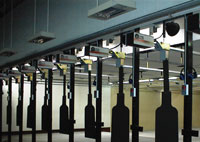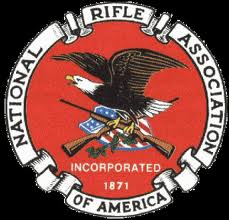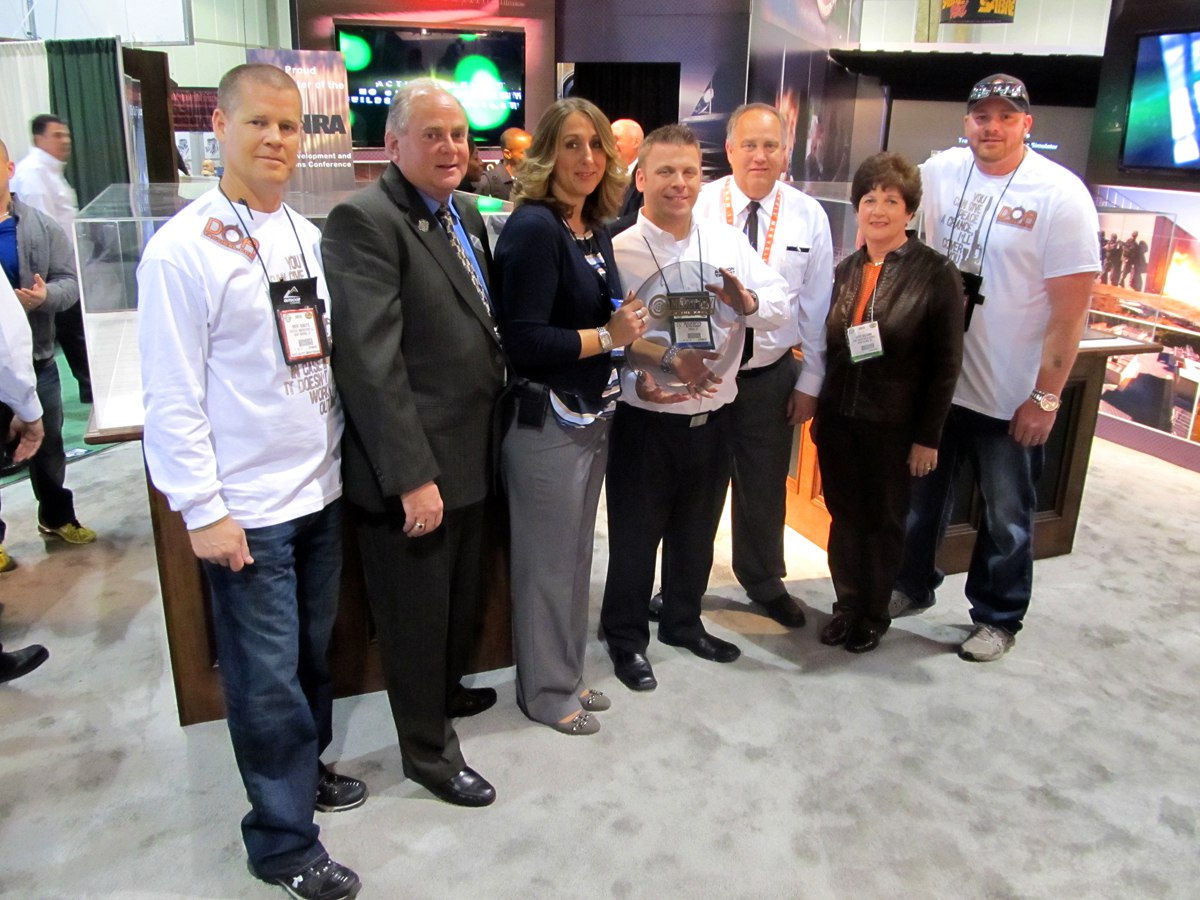Written by Keith Mehlin
Editor’s Note: This article was originally published on August 26, 2010. Due to the popularity of the article and the number of new subscribers since it originally went out, Action Target has decided to republish this two part series.
The Council Bluffs Police Department had an outdoor 50 yard range for 30 years plus located near the Council Bluffs Airport. This range was built in a large depression which was protected by dirt berms on all sides, including a wall of dirt approximately 20 feet high behind the target area. Approximately 5 years before the range was closed we had added computer controlled turning targets from Action Target and a two story control tower. The tower was built with the help of the FBI. Our range was built in such a way that we could easily place vehicles, both cruisers and simulated suspect vehicles, and other types of items to simulate cover and concealment on the range, quite easily. We also had a small structure in one corner of the range that we could use as a shooting house.
The Department scheduled four firearms training sessions yearly for all sworn officers, which were integrated with defensive tactics training. Our tactical team would shoot once a month. Having been a firearms instructor and defensive tactics instructor myself, I know that we were consistently providing for our officers realistic training that would mimic as best we could combat situations on the street.
Once we added the computer controlled target system and the control tower, we did not feel that we were lacking anything. At that time we had no patrol rifle policy so the 50 yard range was adequate for our needs. Nor did we have any safety issues for the officers using the range, which at the time was being used by 24 different agencies in the Omaha metro area. We were not getting any rounds coming back at the officers from the berm behind the target area. We had mined the lead some years before and it appeared to us that it did not need to be done again. We also had no liability issues on the range as far as officers using the range. We had not had an accident or serious injury on the range for the 32 years that I have been a police officer here. The only injury that I can recall came from a top strap blowing on a revolver several years ago, and fortunately that injury was not serious. We were under the impression that with the improvements that we had made, we were good to go for at least another 30 years on the range. Little did we know that was about to change very quickly.
Our troubles began in mid summer of 2002. One of the tenants at a hangar claimed that he had heard a deflected round hit the roof of the metal hangar when he was working on his airplane. He went to the city and the police department and demanded that we immediately close the range. We did not close the range but did an investigation and concluded that a deflected round did leave the range and land on the roof. We contacted Action Target, who immediately flew out and inspected the range. They made some recommendations, which were implemented, and we continued to use the range, believing that was an isolated incident and that we had fixed the problem. This did not please the individual whose roof the spent round landed on.
A few months after that, this same individual made another complaint outlining the same circumstances; however, this time he had the spent round as evidence. After a very brief investigation, we were able to determine that the rounds that were being fired on the range that day were not of the same caliber of the spent round that this person offered up as evidence. Again, we thought we were safe and continued to operate the range.

That all changed a few weeks later when several construction workers, who were working on a building project near the range, reported hearing deflected rounds going over their heads while they were working. I immediately closed the range because of safety concerns. While we will never know exactly how long rounds had been leaving our range, we feel that we became aware of it because of the encroachment upon the range by an airport expansion project and other building projects near the range. Before those projects, we were isolated enough that spent rounds leaving the range was not a recognized problem.
It was at that point we knew that we needed a new range. Not only were we suddenly without a place to train with our firearms, so was 23 other federal, state, and local agencies. I will always remember the feeling of despair when I realized that my officers and many other officers were suddenly without an adequate place to train to defend their lives and the lives of the people they were sworn to defend. We had to build a range.
The questions that we had when we faced up to the task was where to find the money, where to put the range, how big to build it, and what type of range equipment did we want to use. I knew that I wanted to build the best training facility possible for the officers, but I had no idea how to go about it.
Because the city had been caught flat footed with the range suddenly closing without warning, money was definitely the biggest problem. I decided to attack the problem on three fronts: local money, federal money because several federal agencies used the range, and through a local foundation. Early on in the process I came to realize that without more local involvement, the federal and foundation money would not come into play. I contacted Sheriff Jeff Danker, Pottawattamie County Sheriff, the county in which Council Bluffs is located, and we agreed to make this training facility a joint city county venture. After that decision, and jumping through a lot of political and bureaucratic hoops, local, federal and foundation money was obtained for the building of the training facility.
The research and planning stage actually went quicker than I anticipated. We already had a history with Action Target and were pleased with their target equipment and level of service. I had no knowledge of Action Target bullet traps, or any other traps on the market, but I knew that my biggest concern beyond safety was ease and cost of maintenance. After a short amount of research, I thought that Action Target had the corner on the market on ease of maintaining and simplicity of a bullet trap. The decision was made to go with that company for range equipment.
(This article continues in next week’s newsletter)
 First off, it must be remembered that the range exists as the profit center to the business. Secondly, a decision needs to be made in regards to the operations of the range. In regard to the commercial value of a range, there are typically two lines of thought in the industry: one is to combine the range with the store, and the second is to not.
First off, it must be remembered that the range exists as the profit center to the business. Secondly, a decision needs to be made in regards to the operations of the range. In regard to the commercial value of a range, there are typically two lines of thought in the industry: one is to combine the range with the store, and the second is to not.






 The specific purpose of the Portable Target Course Book is to “ensure trainees a program that is designed to develop trainings that are safe, test fundamental skills, increase and enhance movement, improve the target selection thought processes, and enhance overall tactical awareness.” Action Target’s Portable Targets have become an industry standard and leader and the course book allows for a better overall training experience.
The specific purpose of the Portable Target Course Book is to “ensure trainees a program that is designed to develop trainings that are safe, test fundamental skills, increase and enhance movement, improve the target selection thought processes, and enhance overall tactical awareness.” Action Target’s Portable Targets have become an industry standard and leader and the course book allows for a better overall training experience. This is the same concept that is taking place when a bullet travels into the bullet trap. In front of the bullet there is a large wall of air that is being pushed into the trap. When a supersonic crack sounds, what is actually happening is that the bullet is breaking the shockwaves of air. This same air is what is being pushed in the bullet trap. If there were no dust collector on the bullet trap, the overpressure of the air entering the trap would collect surrounding particles and lead dust and shoot it back onto the range. This is where the dust collector becomes essential. The dust collector enables a negative pressure to be established inside the bullet trap, and it functions at a rate that is high enough to overcome the bullets and air pressure entering the trap. Referring again to the example of the cotton ball and the glass, if there was no back on the glass it would be easy to push the cotton ball to the rear of the glass by blowing on it. This is possible because there is no overpressure in the glass.
This is the same concept that is taking place when a bullet travels into the bullet trap. In front of the bullet there is a large wall of air that is being pushed into the trap. When a supersonic crack sounds, what is actually happening is that the bullet is breaking the shockwaves of air. This same air is what is being pushed in the bullet trap. If there were no dust collector on the bullet trap, the overpressure of the air entering the trap would collect surrounding particles and lead dust and shoot it back onto the range. This is where the dust collector becomes essential. The dust collector enables a negative pressure to be established inside the bullet trap, and it functions at a rate that is high enough to overcome the bullets and air pressure entering the trap. Referring again to the example of the cotton ball and the glass, if there was no back on the glass it would be easy to push the cotton ball to the rear of the glass by blowing on it. This is possible because there is no overpressure in the glass. Action Target developed the
Action Target developed the 


